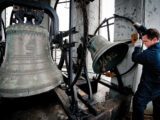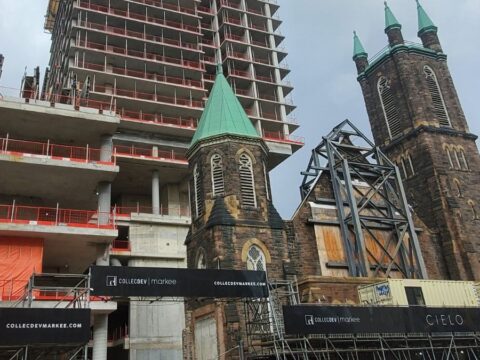Kevin Flatt is a professor of church history at Redeemer University College in Hamilton and the author of After Evangelicalism: The Sixties and the United Church of Canada. He spoke with Ken Gallinger.
Ken Gallinger: Your book’s subtitle is The Sixties and the United Church of Canada. Why should anyone care what happened in the United Church 50 years ago?
You may unsubscribe from any of our newsletters at any time.
Kevin Flatt: The ’60s is when today’s United Church was born. Changes that took place in that decade redefined The United Church of Canada. If you want to understand today’s United Church, you need to go back to the ’60s and see where it came from.
KG: That’s not how United Church people see it. Ask a member when their church was born, and if they have any answer, it would be 1925.
KF: I’m not interested in when the church came into being on paper; I want to know when the United Church acquired the characteristics it has today. Before the 1960s, it’s like a different religion inhabited the same organization.
KG: How would you define the United Church between 1925 and 1960?
KF: In the 19th century, the Methodists and Presbyterians were basically evangelical churches. Toward the end of the 19th century, however, a new theological perspective, usually called liberal, began to gain traction, especially in theological colleges; it eventually shaped the perspective of many ministers.
So when the United Church was formed in 1925, it had an evangelical heritage, but liberal theology was very popular with clergy. Between then and the 1950s, the United Church maintained this dual identity; it had obvious evangelical characteristics, but the leaders themselves had a liberal theology.
KG: Are the terms “evangelical” and “liberal” incompatible?
KF: There were people, like J.R. Mutchmor [moderator of the United Church from 1962 to 1964, and longtime secretary of the Board of Evangelism and Social Service], who espoused traditional evangelical practices but whose theology was typical of United Church ministers. Mutchmor didn’t see tension between those two things. But in the ’60s, a younger generation of ministers certainly saw an incompatibility, and I think they were right.
KG: Let’s clarify terms. What are the keystones of an evangelical church?
KF: Evangelicalism takes the Bible as a reliable and authoritative guide to life. It also believes in the importance of conversion and a personal faith in Christ. It believes in spreading this message so that people will become believers.
In parallel, liberalism’s fundamental characteristic is a belief that Christianity needs to be updated, evolving to keep up with modern thought. This goes along with a more skeptical attitude toward the Bible and traditional doctrine.
KG: A lot of this is about the way the Bible is read. Give me a summary of the difference.
KF: The liberal viewpoint is that the Bible is what people have thought about God through the centuries; as civilization progresses, some of those ideas become out of date. An evangelical view believes that the actual content of scripture, while written by people, is actually inspired by God, right down to specific teachings. So it never goes out of date.
KG: So, in that interregnum between 1925 and 1960, the United Church behaved like an evangelical institution, but its leaders operated out of a liberal theology?
KF: Right. It was a period of compromise and co-existence.
KG: Then along come the ’60s . . .
KF: Yes, and a number of things happened. The denomination had been planning a new Sunday school resource, known simply as the New Curriculum. It had the aim of actually bringing liberal theology to the pews. It was the first time the United Church had done this, and leaders were taken aback at the backlash from people who didn’t know that their ministers didn’t believe in the virgin birth or physical resurrection.
There was also new leadership at the Board of Evangelism and Social Service — a guy named J.R. Hord. He dropped the traditional evangelism that the board had done and concentrated on social and political issues. Along with that, the United Church dissociated from Billy Graham, the evangelist.
Finally, there was, throughout Christianity, the emergence of radical theologies — the death of God movement and so on. This provoked public comments, usually very positive, from United Church leaders . . . which again shocked many lay people.
KG: But at the same time, there was a lot of affirmation.
KF: Yes, there was. Liberalism resonated with many church members. It was the conflict, though, that defined the debate, and what ended up happening is that United Church leaders reacted against the critics in a way that almost defined them as outside the church. Evangelicals felt excluded, angry, driven out.
KG: The New Curriculum was a huge seller, broadly endorsed at the congregational level across the country. But you tie that broad-scale use to a decline in Sunday school enrolment. Is that fair, given that the same thing was happening in other churches across North America?
KF: It’s true that there was a major decline across Protestant denominations. So you can’t see the curriculum as the single cause. But I do see a very dramatic one-year drop when the New Curriculum was introduced. And there are lots of letters in the archives from people saying, “I don’t like the curriculum, so my kids won’t be back.”
KG: So if this period was the birth of the modern United Church of Canada, how have the trends we’ve been talking about shaped the church?
KF: On the negative side, the numerical decline that began in the 1960s has continued almost uninterrupted. But the idea of the church listening to the world, then getting on board with progressive movements around it, has continued to characterize the United Church; it’s something the church takes pride in.
Before [the 1960s], leaders spoke of the church as a positive influence on society — the church’s job was to bring society up to the level of the church. But there was a Copernican revolution in the ’60s — a much more positive view of the world, and an understanding that the church needed to learn from the world.
In the ’50s, the idea was, “The church has the answers, and our job is to share those answers with society.” In the ’60s, the idea was, “The church has been part of the problem, and maybe answers are to be found elsewhere . . . in political theories, psychology, the sexual revolution. So maybe we need to get on board with them.”
KG: What advice would you give to United Church leaders concerned with the survival of the institution?
KF: The church is in dire straits, and we may be looking at the disappearance of the denomination. So I’d say, have a look at which churches are growing and ask, “Are there things going on that we could adopt as well?” That may mean looking at forms of spirituality that are not very strong in the United Church right now.
KG: Some in the United Church would say, “It’s better to be honest, open and relevant than to be popular. We need to speak the truth, and if the denomination dies, so be it.” They might say that what happened in the ’60s was that ministers finally started speaking theological truth, even though it was unpopular. What do you say to that?
KF: There is a link between the theology of the 1960s and the decline of the church. If the leaders of the United Church really believe their theology
is true, then the right thing is to stick to their guns, even at the cost of
the institution. But if they believe the institution is valuable, that may mean soul-searching. Sometimes the idea of keeping up with society is presented by advocates as the way for the church to survive. That’s a plausible position . . . except that it hasn’t worked, and it doesn’t work.
This interview has been edited and condensed.
***
This story first appeared in The United Church Observer’s October 2013 issue with the title “‘If you want to understand today’s United Church, you need to go back to the ’60s .’”















Thanks to Broadview for remembering our roots and struggles. I remember vividly the leadership of Ray Hord and the publication of the New Curriculum in the 60s.
As a child who went to the United Church of Canada I experienced the new curriculum and it was very damaging to my faith. I took from it that the Bible was full of myths and fallacies and not to be believed. It was only at age 30 when I met an evangelical Christian from Moody Bible Institute that I realized there was good reason to believe the Bible and to have faith in God. The movement did me terrible damage, but I am thankful to have met a missionary who helped me to discover God. I have now completed a MTS at Wycliffe College in Toronto but I pray for my family who go to the United Church and do not have the assurance I have as to the truths of the Bible.